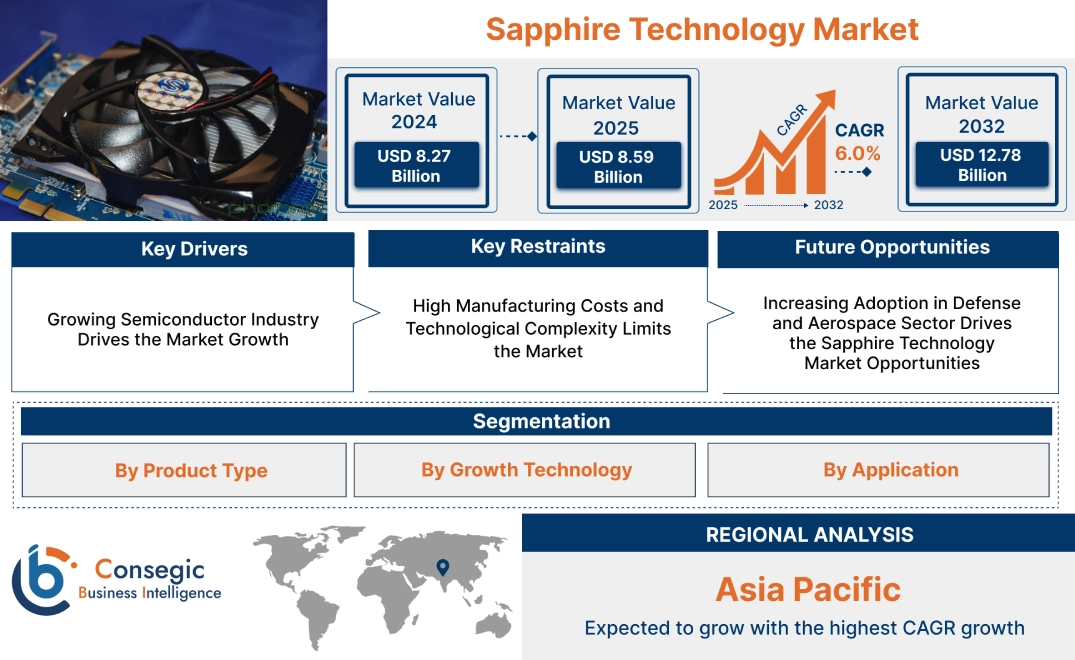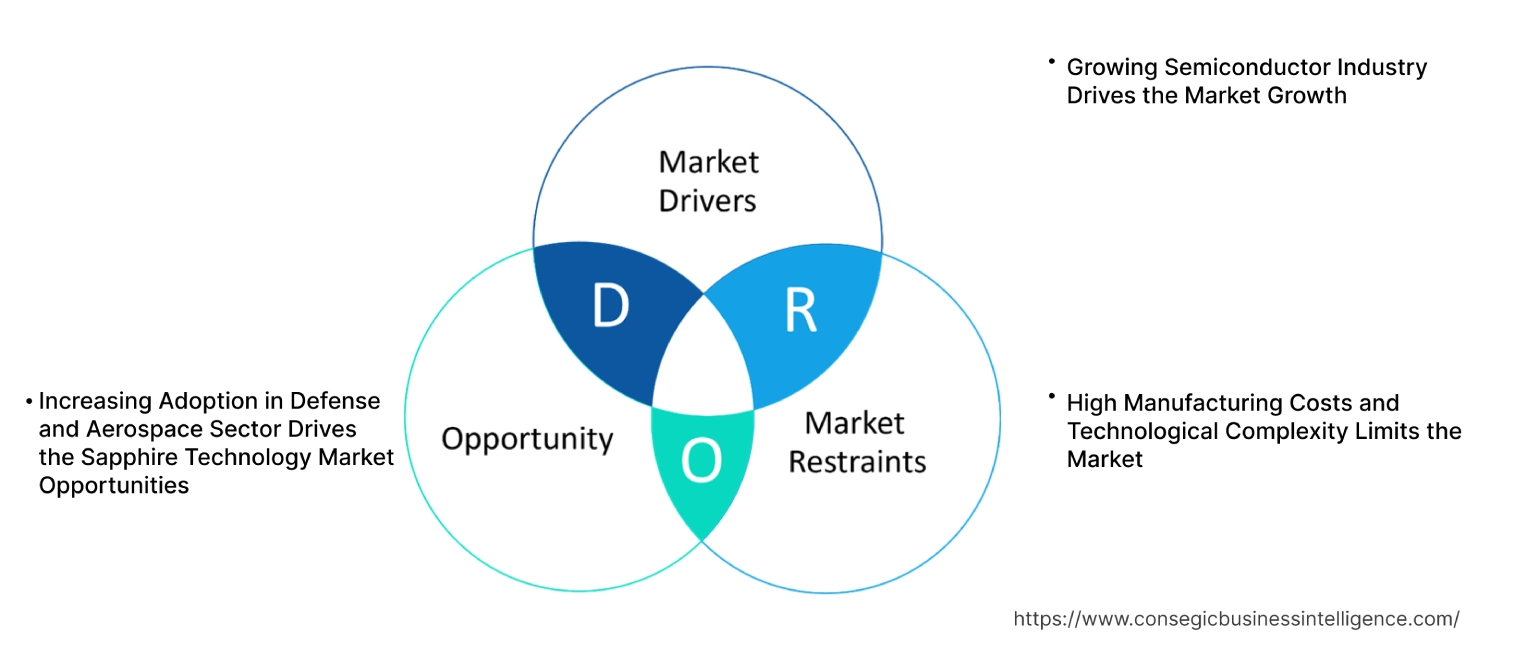- Summary
- Table Of Content
- Methodology
Sapphire Technology Market Size:
Sapphire Technology Market Size is estimated to reach over USD 12.78 Billion by 2032 from a value of USD 8.27 Billion in 2024 and is projected to grow by USD 8.59 Billion in 2025, growing at a CAGR of 6.0% from 2025 to 2032.
Sapphire Technology Market Scope & Overview:
Sapphire technology refers to the utilization of synthetic sapphire, a single crystal form of aluminum oxide, in various applications due to its exceptional hardness, optical clarity, and thermal stability. Further, sapphire technology has applications across wide range of sectors including consumer electronics, aerospace and defense, information and communication technology (ICT), power sector, and healthcare. Furthermore key trends driving the market include increasing need for sapphire in premium consumer electronics devices and the growing adoption of sapphire substrates in advanced LED and semiconductor devices.
Key Drivers:
Growing Semiconductor Industry Drives the Market Growth
The growing semiconductor industry acts as a significant catalyst for the sapphire technology market. The semiconductors have become integral part of the modern electronics which in turn drives the requirement for high-quality substrates. Sapphire's unique properties, including thermal stability, electrical insulation, and hardness, make it crucial in various semiconductor applications, particularly in power electronics and RF devices. Further, need for higher efficiency and performance requires sapphire which is capable of withstanding extreme conditions. Moreover, the growing complexity of semiconductor designs, especially in advanced technologies like 5G and AI, requires substrates with superior characteristics.
- For instance, according to the Semiconductor Industry Association (SIA) Global semiconductor sales reached USD 627.6 billion in 2024, marking a 19.1% increase from 2023.
Thus, the rise of the semiconductor sector directly translates to a heightened need for sapphire wafers and substrates, fueling the market.
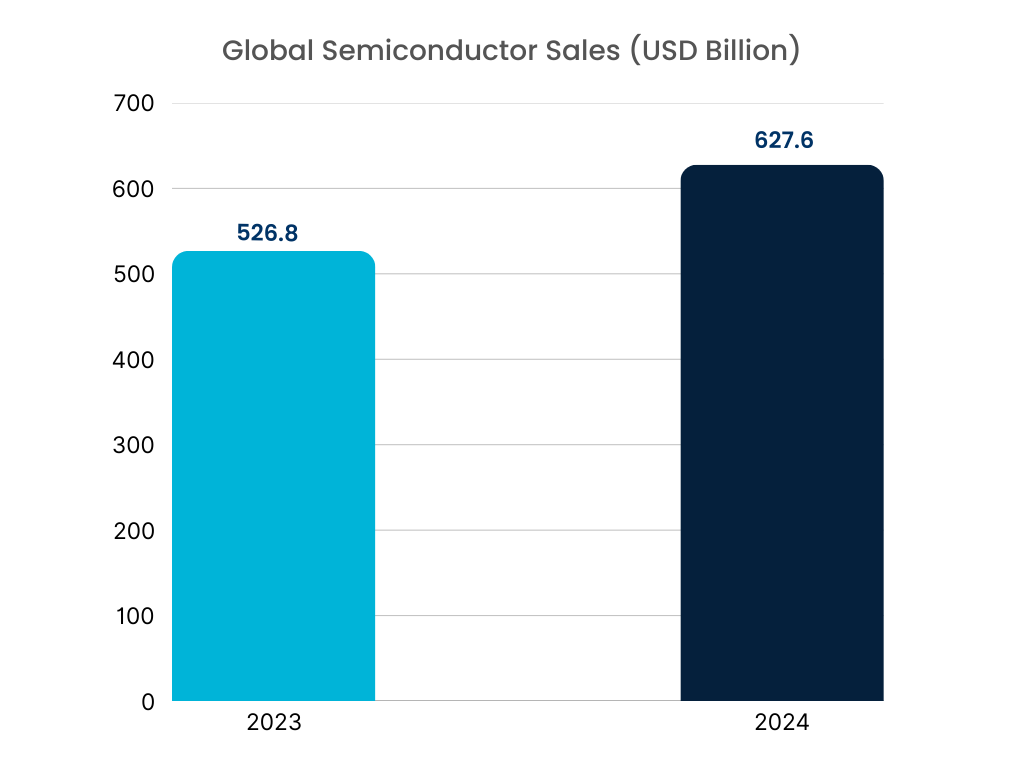
Key Restraints:
High Manufacturing Costs and Technological Complexity Limits the Market
The sapphire technology market faces significant hurdles due to high manufacturing costs and inherent technological complexities. The production of high-quality sapphire crystals involves intricate processes, requiring specialized equipment and skilled labor, which drives up expenses. Further, growing large, defect-free crystals necessitates precise control of temperature and atmospheric conditions, adding to the technological challenge. Furthermore, the energy-intensive nature of Kyropoulos and HEM processes, contributes substantially to production costs. Thus, as a result, the high cost and intricate manufacturing processes remain significant constraints on the sapphire technology market's expansion.
Future Opportunities :
Increasing Adoption in Defense and Aerospace Sector Drives the Sapphire Technology Market Opportunities
The increasing adoption of sapphire technology within the defense and aerospace sectors presents a substantial opportunity for market. Sapphire offers exceptional hardness, optical clarity, and resistance to extreme conditions making it ideal for defense and aerospace sector. In aerospace sector, sapphire windows are crucial for optical sensors and targeting systems, while its durability enhances sensor protection in harsh environments. Moreover, the growing need for advanced sensor technology, lidar systems, and high-performance optical components is driving the market. As defense and aerospace technologies advance, the need for materials that can withstand rigorous conditions intensifies, further fueling the need for sapphire.
- For instance, Rubicon Technology offers large-area sapphire windows that are utilized in electro-optics, defense, aerospace, and transparent armor systems for both defense and commercial transportation.
Thus, growing adoption in defense and aerospace sector drives the sapphire technology market opportunities.
Sapphire Technology Market Segmental Analysis :
By Product Type:
Based on the product type, the market is segmented into sapphire wafers sapphire ingot, sapphire crystal screens, sapphire windows, and others.
Trends in the Product Type:
- Increasing trend towards providing customized sapphire window solutions to meet the requirements of aerospace, defense, and industrial applications is driving the sapphire technology market trends.
- Increasing need for ingots with higher purity levels is expected to drive sapphire technology market size.
Sapphire wafers accounted for the largest revenue share in the year 2024.
- Increasing need for larger diameter sapphire wafers including 6-inch, 8-inch, and beyond is driving the sapphire technology market share.
- Further, focus on improving wafer quality by reducing defects, enhancing surface smoothness, and ensuring consistent crystal orientation is driving the market.
- Furthermore, growing use of sapphire wafers in RF devices, power electronics, and advanced sensors is driving the sapphire technology market trends.
- Thus, as per sapphire technology market analysis, increasing wafer size, enhanced wafer quality, and diverse applications are driving the market.
Sapphire crystal screens is anticipated to register the fastest CAGR during the forecast period.
- Growing use of sapphire crystal screens in premium smartphones, smartwatches, and other wearable devices due to superior scratch resistance drives the sapphire technology market share.
- Further, technological advancements in thinning and polishing sapphire screens are enabling thinner, lighter, and more visually appealing devices which in turn drives the sapphire technology market demand.
- Furthermore, increasing consumer requirement for larger displays in turn drives the need for larger sapphire crystal screens.
- Therefore, based on analysis, growing application in premium devices, technological advancements, and demand for larger sapphire crystal screens is anticipated to boost the market during the forecast period.
By Growth Technology:
Based on the growth technology, the market is segmented into Kyropoulos (KY) Method, Edge Defined Film Fed Growth (EFG), Horizontal Directional Crystallization (HDC), Heat Exchanger Method (HEM), and czochralski method.
Trends in the Growth Technology:
- Edge defined film fed growth method is used to produce more complex and precise shaped sapphire crystals, reducing the need for post-processing, in turn driving the sapphire technology market demand.
- Horizontal Directional Crystallization (HDC) is being optimized for the production of very large sapphire crystals, catering to applications requiring large substrates which in turn drives the market.
Kyropoulos (KY) Method accounted for the largest revenue share in the year 2024.
- Growing focus towards automating the Kyropoulos process to improve consistency which in turn drives the sapphire technology market size.
- Further, growing focus to minimize defects and impurities in Kyropoulos-grown crystals, enhancing their suitability for high-performance applications is driving the sapphire technology industry.
- Thus, as per sapphire technology market analysis, focus on automation and improved crystal quality is driving the market.
Heat Exchanger Method (HEM) is anticipated to register the fastest CAGR during the forecast period.
- Growing Improvements in the HEM process by minimizing stress and defects in the crystals which in turn enhances the optical and mechanical properties.
- Further, HEM is being refined to produce sapphire crystals with exceptionally high purity levels, meeting the stringent requirements in turn propelling the sapphire technology market expansion.
- Therefore, based on analysis, aforementioned factors are anticipated to boost the market during the forecast period.
By Application:
Based on the application, the market is segmented into consumer electronics, aerospace and defense, ICT applications, power sector applications, others.
Trends in the Application:
- Sapphire's electrical properties are driving up its use in RF devices for telecommunications and wireless applications which in turn drive the market.
- Growing use of sapphires due to high thermal conductivity and electrical insulation properties are making it suitable for high-power electronics applications which subsequently propel the sapphire technology market.
Consumer electronics accounted for the largest revenue share of 36.43% in the year 2024.
- There's a trend towards using sapphire for larger screens and camera lens in turn driving the market
- Further, applications requiring high optical clarity, such as camera lenses and optical sensors, are driving the demand for high-quality sapphire.
- Furthermore, growing demand for premium smartphones in turn drives the sapphire technology market growth.
- Therefore, based on analysis, larger display protection, enhanced optical clarity, and growing demand for premium smartphones are driving the market.
Aerospace and defense is anticipated to register the fastest CAGR during the forecast period.
- Sapphire's hardness and optical transmission are driving its use in advanced optical windows for sensors, targeting systems, and aerospace applications.
- Further, sapphire's high melting point and thermal stability make it suitable for high-temperature applications in aerospace and defense in turn driving the sapphire technology market growth.
- Furthermore, increasing use of sapphire windows within Lidar systems, due to its optical properties in turn driving the sapphire technology market expansion.
- Therefore, based on analysis, the aforementioned factors are anticipated to drive the market during the forecast period.
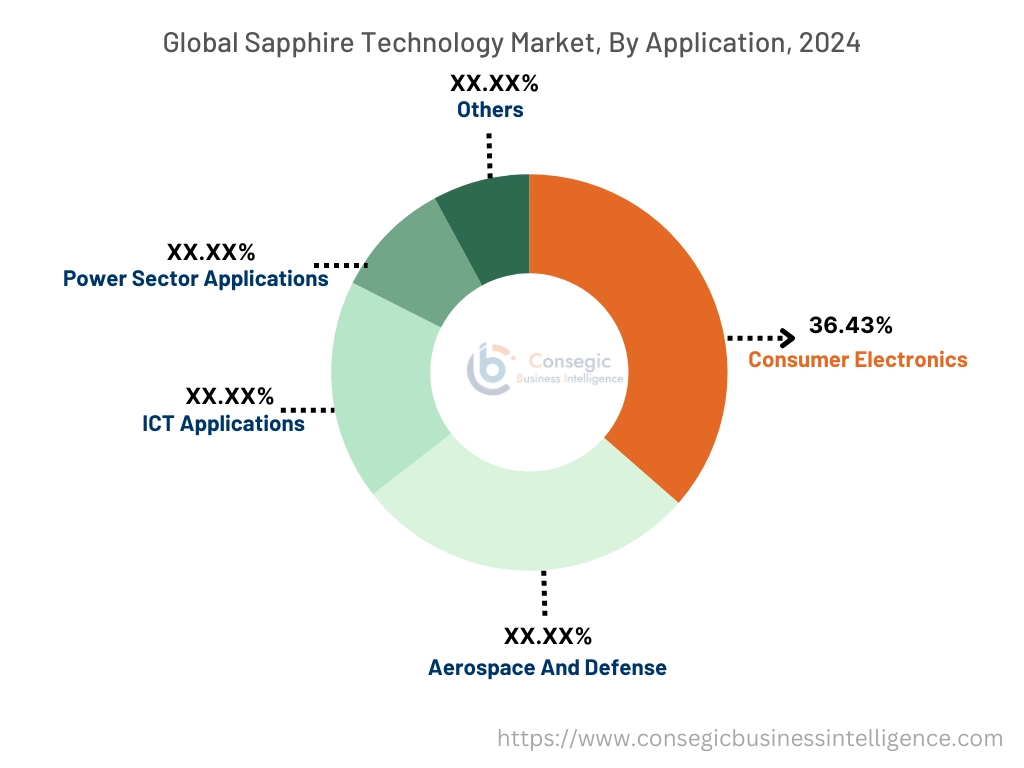
Regional Analysis:
The regions covered are North America, Europe, Asia Pacific, the Middle East and Africa, and Latin America.
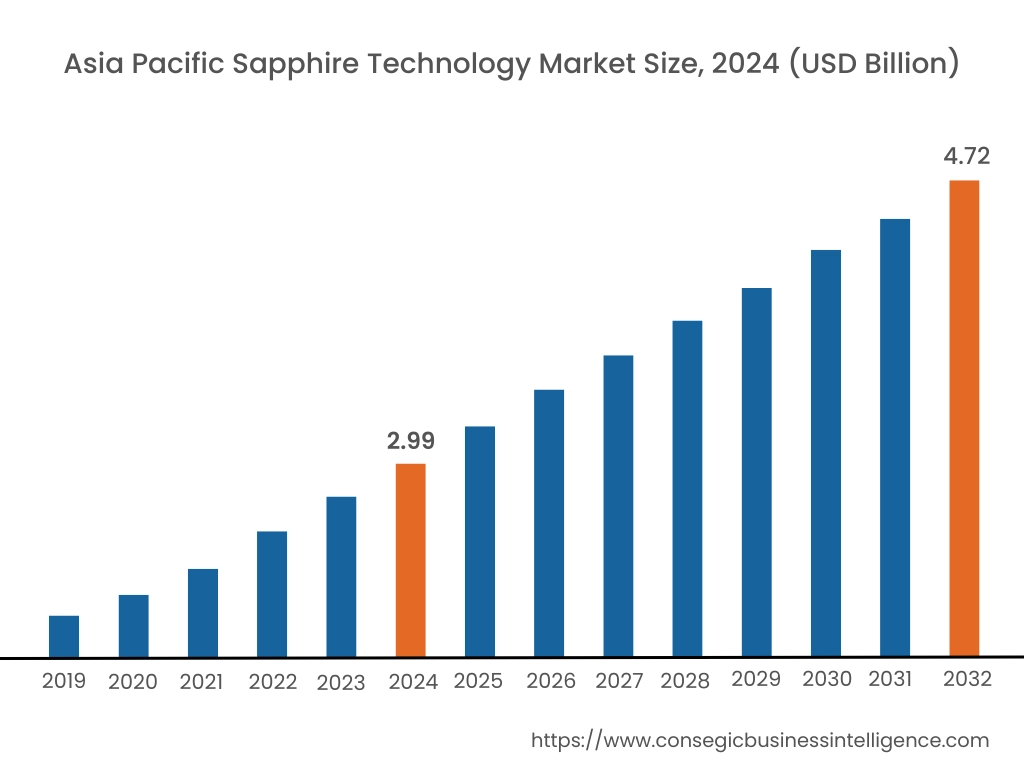
Asia Pacific region was valued at USD 2.99 Billion in 2024. Moreover, it is projected to grow by USD 3.11 Billion in 2025 and reach over USD 4.72 Billion by 2032. Out of this, China accounted for the maximum revenue share of 32.64%. The market growth for sapphire technology is mainly driven by robust consumer electronics sector where sapphire is mainly used in smartphones and wearables. Additionally, the strong presence of LED manufacturing hubs and the increasing adoption of energy-efficient lighting solutions further fuel the market's rise in Asia-Pacific region.
- In August 2020, Monocrystal secured approval for a USD 75 million per year project to manufacture large-diameter sapphire wafers for advanced LED applications.
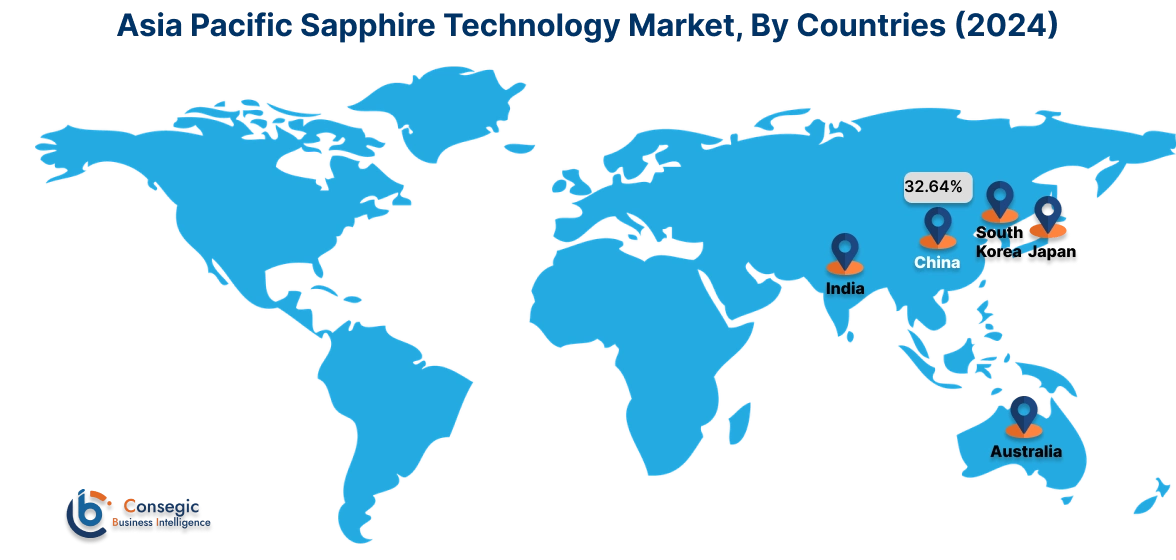
North America is estimated to reach over USD 3.46 Billion by 2032 from a value of USD 2.25 Billion in 2024 and is projected to grow by USD 2.33 Billion in 2025. The North American market is primarily driven by strong focus on advanced technology particularly in the aerospace and defense sectors. Furthermore, the increasing adoption of sapphire in high-end consumer electronics and LED lighting solutions also contributes significantly to the market.
The regional trends analysis depicts that increasing need for energy-efficient LED lighting solutions and the growing requirement for premium smartphones and medical devices in Europe is driving the market. Additionally, the factors driving the market in the Middle East and African region are increasing investments in infrastructure development, particularly in telecommunications and energy sectors. Further, expanding telecommunications infrastructure and increasing adoption of consumer electronics, alongside gradual growth in industrial applications is paving the way for the progress of market trends in Latin America region.
Top Key Players and Market Share Insights:
The global sapphire technology market is highly competitive with major players providing solutions to the national and international markets. Key players are adopting several strategies in research and development (R&D), product innovation, and end-user launches to hold a strong position in the sapphire technology industry. Key players in the global sapphire technology market include-
- Monocrystal Inc. (Russia)
- Rubicon Technology (US)
- Fraunhofer-Gesellschaft (Germany)
- Crystal Systems (US)
- Kyocera Corporation (Japan)
- Otto Chemie Pvt Ltd (India)
- Orbray Co., Ltd. (Japan)
- CRYSCORE (China)
- Crystran Ltd. (UK)
- Thorlabs, Inc (US)
Sapphire Technology Market Report Insights :
| Report Attributes | Report Details |
| Study Timeline | 2019-2032 |
| Market Size in 2032 | USD 12.78 Billion |
| CAGR (2025-2032) | 6.0% |
| By Product Type |
|
| By Growth Technology |
|
| By Application |
|
| By Region |
|
| Key Players |
|
| North America | U.S. Canada Mexico |
| Europe | U.K. Germany France Spain Italy Russia Benelux Rest of Europe |
| APAC | China South Korea Japan India Australia ASEAN Rest of Asia-Pacific |
| Middle East and Africa | GCC Turkey South Africa Rest of MEA |
| LATAM | Brazil Argentina Chile Rest of LATAM |
| Report Coverage |
|
Key Questions Answered in the Report
How big is the Sapphire Technology market? +
The Sapphire Technology market is estimated to reach over USD 12.78 Billion by 2032 from a value of USD 8.27 Billion in 2024 and is projected to grow by USD 8.59 Billion in 2025, growing at a CAGR of 6.0% from 2025 to 2032.
What specific segmentation details are covered in the sapphire technology report? +
The sapphire technology report includes specific segmentation details for product type, growth technology, application, and regions.
Which is the fastest segment anticipated to impact the market growth? +
In the sapphire technology market, aerospace and defense is the fastest-growing segment during the forecast period.
Who are the major players in the sapphire technology market? +
The key participants in the sapphire technology market are Monocrystal Inc. (Russia), Rubicon Technology (US), Fraunhofer-Gesellschaft (Germany), Crystal Systems (US), Kyocera Corporation (Japan), Otto Chemie Pvt Ltd (India), Orbray Co., Ltd. (Japan), CRYSCORE (China), Crystran Ltd. (UK), Thorlabs, Inc (US), and others.
What are the key trends in the sapphire technology market? +
The sapphire technology market is being shaped by several key trends including growing consumer electronics sector and increasing adoption of sapphire in aerospace and defense.
